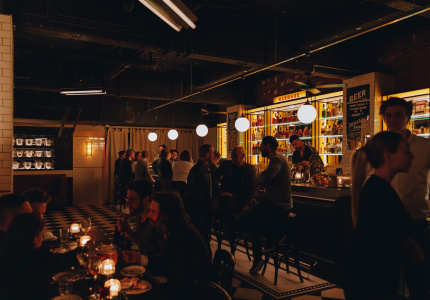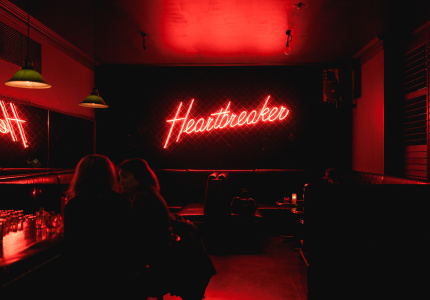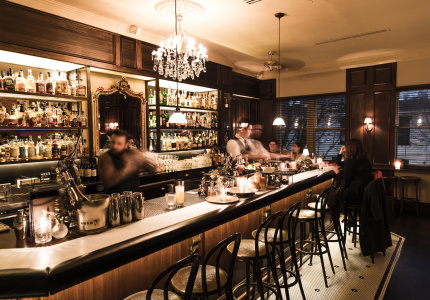The narrow basement reverberates with the nasal whine of power tools. In one corner a guy is methodically bashing something with a hammer. A thick layer of dust covers every surface, the bar is missing its top and extension cords criss-cross the floor like leftover spaghetti on a plate. The place reeks of paint and sawdust.
The Madrusans Make Drinks Better
Michael and Zara Madrusan run three of Melbourne’s best cocktail bars: Heartbreaker, the Everleigh and now Bar Margaux. But their impact extends beyond the walls of these world-class venues. Through a growing flock of innovative side businesses – including hand-cut ice and bottled cocktails – the ambitious duo is elevating drinks right across the city in a way no bar, or bars, has managed to.
A week from now, in late June, this room off Lonsdale Street will apparently be ready to serve French food and top-shelf cocktails as the swanky Bar Margaux. Invitations have already been sent out to family, friends and media.
I carefully pick my way through the mess, paying extra attention to my feet. I spot owners Michael and Zara Madrusan up the back, heaving a big marble table into position. She’s willowy and sports a blonde pixie cut that’s on the longer side. He’s bearded, broad-shouldered and favours denim shirts. Today they’re wearing jeans, hoodies and matching leather jackets – his black, hers baby blue. “Oh hey – welcome,” they call over the din, looking exhausted and a little defeated. I remember they have a 13-month-old baby at home.
In this brief, vulnerable moment, they don’t seem like two people responsible for some of Melbourne’s most essential bars. Nor several related businesses that have quietly improved the entire city’s drinking credentials at a scale no bar, or bars, has managed to.
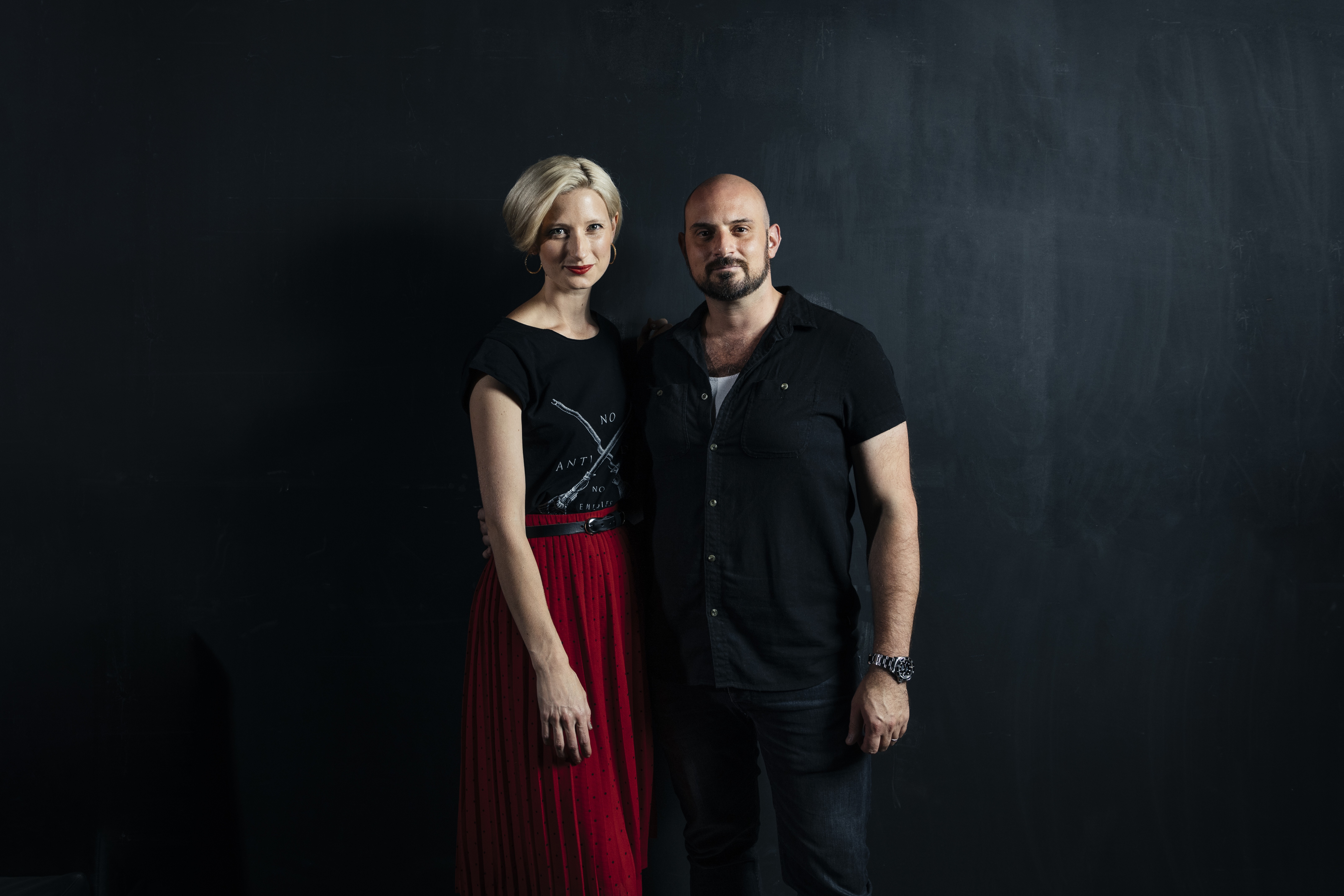
You’ve probably heard of the Everleigh, the debonair cocktail bar on Gertrude Street in Fitzroy. That’s theirs. So is Heartbreaker, the rowdy jukebox-powered haunt on the corner of Lonsdale and Russell streets that’s arguably become even better known than its older sibling. But these two very different powerhouses are just the most public expressions of the Madrusans’ efforts.
I’m here to learn more about Made in the Shade, the umbrella company under which all the couple’s other projects sit. A sizeable number of their 80 employees don’t work in bars at all – they produce peerless ice and bottled cocktails for other bars and restaurants.
The basement is too loud for conversation, so we decamp one block down to Heartbreaker, where the staff is setting up for the night ahead. It’s dark inside, as usual. But it’s weird to see it silent and empty, rather than packed with people shooting pool, waving their drinks around and belting out Springsteen.
“Margaux has been the hardest thing to get done,” Michael says as the three of us settle into a booth for a beer. “We’ve put all the money – everything we’ve got – into it. We’ve had to borrow again from my parents to help us out of trouble.” For the past two weeks he’s been working from 6am to midnight, with only a brief dinner break at home to see his daughter, Molly.
The Madrusans weren’t expecting to open Margaux just now, is the thing.
Last September Michael was out the front of Heartbreaker, putting the new opening hours in the window. Stefano Rassu, the owner of nearby Italian restaurant Pomodoro Sardo, was walking past. “He goes, ‘Hey Mike! I want to get rid of my basement. You should come and take a look.’ I said, ‘Pal, I’m busy enough right now, I don’t need it’.”
Michael changed his mind after Rassu mentioned the place had a coveted 24-hour licence. He went to have a look and quickly realised the basement could scratch a decade-old itch of his: building a late-night venue saluting New York restaurateur Keith McNally and his stable of classic French-American brasseries, including Balthazar, Odeon, Pastis and Schiller’s. It had to be done then, regardless of whether the timing was right. In the name of research, Michael flew back to NYC late last year and visited 39 bars and restaurants in five days.
To secure the basement they had to engage lawyers and spend six painful months negotiating with the landlord via Rassu. Even in the world of hospitality, where costs always run over and timelines always blow out, this was an unusually tall hurdle.
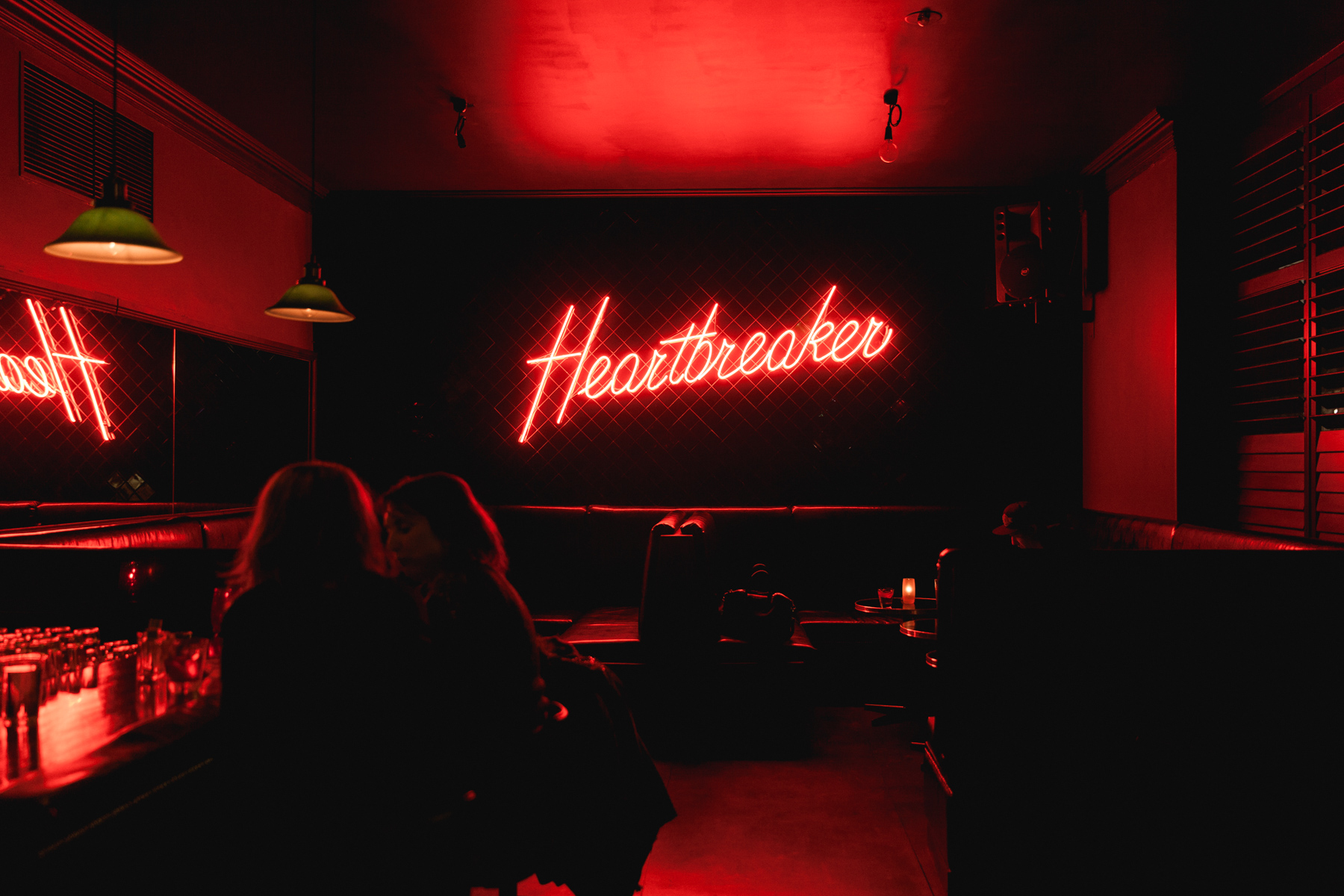
Michael, who grew up in Newcastle, developed a crush on McNally’s restaurants during a four-year stint working in some of New York’s most influential cocktail bars: Milk & Honey, Little Branch and PDT. He’s a little tired of discussing this period of his life, and media constantly referencing it. It was 10 years ago, and he’s proud of Melbourne and the drinking culture we have here. But it’s impossible to tell his story without touching on this formative time.
It was there, in New York, that Michael met his eventual business partner, Milk & Honey founder Sasha Petraske. Petraske, who passed away in 2015 at the age of 42, is to cocktails what David Bowie is to pop music, or Noma chef Rene Redzepi is to restaurants. Over 16 years he shifted the entire industry’s direction, ushering in the current era of fresh ingredients, high-quality booze and previously unheard-of levels of professionalism and attention to detail.
“Mr Petraske’s role in the modern cocktail revival is difficult to overstate,” the New York Times wrote in an obituary. “The opening of Milk & Honey in 1999, in a narrow space on a dark, little-populated block of the Lower East Side, has been called instrumental in the revival of cocktail culture across the United States and beyond.”
In 2008, with five bars already to his name, Petraske decided to go into business with Michael. The duo opened the Everleigh in 2011, through a nondescript doorway and up a staircase off Gertrude Street. It offered – and continues to offer – a more profound sense of escapism than the dim, gilded interior and clandestine location could confer alone.
The smartly attired bartenders and door hosts take their style cues from the 1930s. The women wear elegant cocktail dresses, the men pinstriped pants, suspenders and ties. They have 20th-century manners, too. Guests are received at the door, ushered to their seats and waited on as if in a fine restaurant, though with a distinctly 21st-century wit. In this elegant, meticulously considered space, the outside world can be properly forgotten, if only for a few hours.
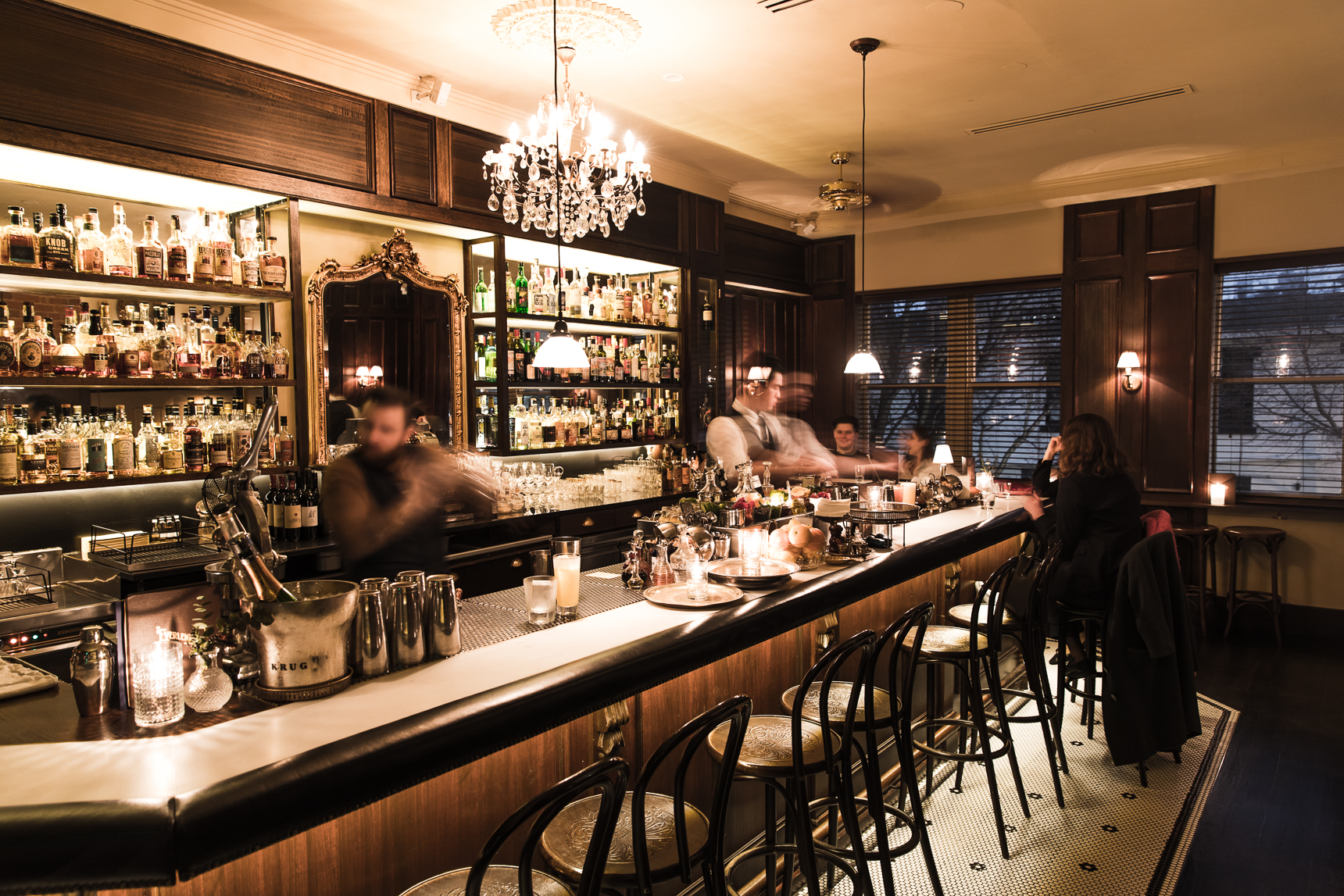
Beyond peerless service, the bar also set an extraordinary standard for cocktails. The drinks – golden-age classics such as Negronis, Sazeracs, Manhattans, Fizzes, Sours and Old Fashioneds – weren’t new, so much as refined to a sublime level. The Everleigh was one of the first bars in Australia to forego an ice machine in favour of hand-cutting its own blocks. It did – and still does – squeeze all fruit juice to order, rather than making a single large batch before service. And the bar doesn’t use speed pourers, for fear of tainting its drinks. Only professional bartenders and the most fastidious of drinkers will notice these details, but they’re representative of a deep commitment to quality – one that’s inspired many local bars to lift their standards.
Zara arrived in Melbourne in 2013, the same year the Everleigh debuted at number 24 on the World’s 50 Best Bars List. She still speaks with the refined, gentle accent of her native England. Within seven days of walking off the plane she’d landed a door-hosting job at “the Ev” through a friend of a friend. “If I was going to be in Melbourne and be in hospitality, I wanted to be at the best venue, no questions asked,” she says.
Once she was inside, though, she saw room for improvement. “Michael was running things pretty mum and pops, the only way he knew how,” Zara says, drawing a hearty, you’re-so-right laugh from Michael. “It was like, ‘You’ve got one of the best bars in the world here, but you’re not telling anyone about it’.”
Being the only non-bartender, Zara soon became the group’s de facto marketing and communications manager, a role she inhabits to this day. Where Michael brings bartending expertise and new ideas to Made in the Shade, she realises things on a practical level: branding, contracts, press releases, marketing and so on. It’s a different kind of attention to detail, but it’s just as important as Michael’s.
But if Zara slipped into her professional role with ease, the couple’s romantic entanglement was more difficult to sort out. Acknowledging their feelings would obviously alter the dynamic of the Everleigh’s small five-person team.
“We were very, very close friends for a long time,” Zara says. “And then we said, ‘Okay, this is a thing. Let’s do it the right way and go to the team about it.’” They married in San Sebastian, Spain, in 2017.
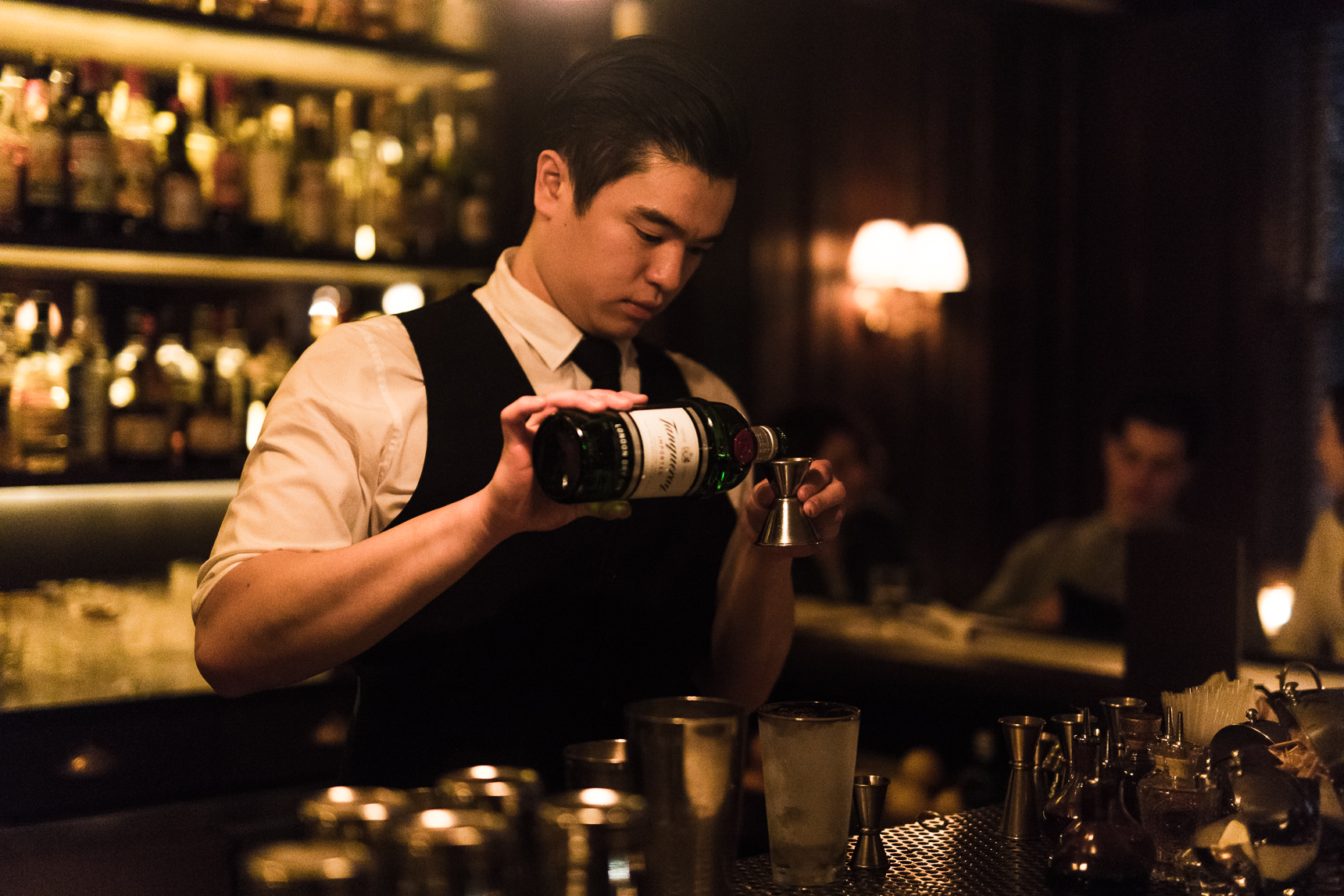
If the Everleigh is the flagship that inspired an industry and showed what’s possible at the very top end, Heartbreaker (opened in 2015) is the populist, good-times bar that really put Made in the Shade on the map for everyday drinkers.
“People talk about this place as if it’s been here for 25 years – like it’s integral to the city scene; like it’s an institution,” Zara says, waving her hand at the darkened room. “The reviews we get say stuff like, ‘First time in. My new favourite bar. I love this place’.”
“Yeah, it’s funny,” Michael adds. “People are emotional about it. You don’t get that with the Ev. People say, ‘Oh, I love the Everleigh, it’s so beautiful, the drinks are lovely, the service is great’,” he says in a flat, emotionless voice. “But when it comes to Heartbreaker it’s, ‘Oh my God, I fucking LOVE that place!’”
These comments are easy to empathise with. No matter the time or day, Heartbreaker always seems like a party. The neon-lit bar is an emotional rip-tide, dragging you to a better headspace, regardless of how your day’s going or whether you even like classic rock (played dangerously loud, no less). There are plenty of bars around town successfully replicating America’s characterful, timeworn dives, but Heartbreaker is the only one pairing this rowdy character with a high-end bartending mindset. Even at 2am, when you’re six drinks deep, it makes a difference.
“I go all method actor when we put this shit together. Even the straw and napkin caddies on that bar are from the ’70s,” Michael says, pointing at Heartbreaker’s padded black counter and smiling at his own fanaticism. “We go all the way. There’s no other way to do it, otherwise you’re just having a laugh.”
Heartbreaker pours a lot of beers, but as you’d expect, cocktails are its real point of difference. Every single drink, even a basic Jack Daniels and Coke, uses a single large chunk of “block” ice, rather than a jumble of smaller cubes. This has been the industry standard in high-end cocktail bars for some time now. It melts more slowly, making drinks last longer and reducing dilution, which tends to dull flavours and mask a drink’s complexities.
Block ice can be made in a regular freezer, albeit with a lot of wastage and mess. Some cocktail bars do, but without the right space and equipment, the cutting process takes a physical toll on staff and often isn’t worth the time and staffing costs.
The Madrusans’ Navy Strength Ice Co, which produces the big, glassy rocks found in almost every cocktail at the Everleigh, Heartbreaker and now Margaux, has changed all that. For the admittedly expensive price of 85 cents a block, the Collingwood-based company has made flawless ice available to anyone, subtly lifting the quality of drinks all over Melbourne. Cocktail bars such as Black Pearl, 1806 and Eau De Vie are all customers, alongside restaurants Attica, Minamishima and Dinner by Heston.
The business started with a single American-made Clinebell ice machine, imported here for $14,000. Now it has eight of the beasts, which take three days to gradually purify and freeze water into immense 140-kilogram blocks completely devoid of air bubbles or imperfections. Six full-time staff then winch the blocks out and use electric chainsaws, bandsaws and manual tools to carve out cubes, batons and other shapes. The final product has no equal in Australia. It chills drinks to the lowest possible temperature (about two degrees) and melts incredibly slowly. It also looks beautiful – like a giant, priceless crystal bobbing in your glass.
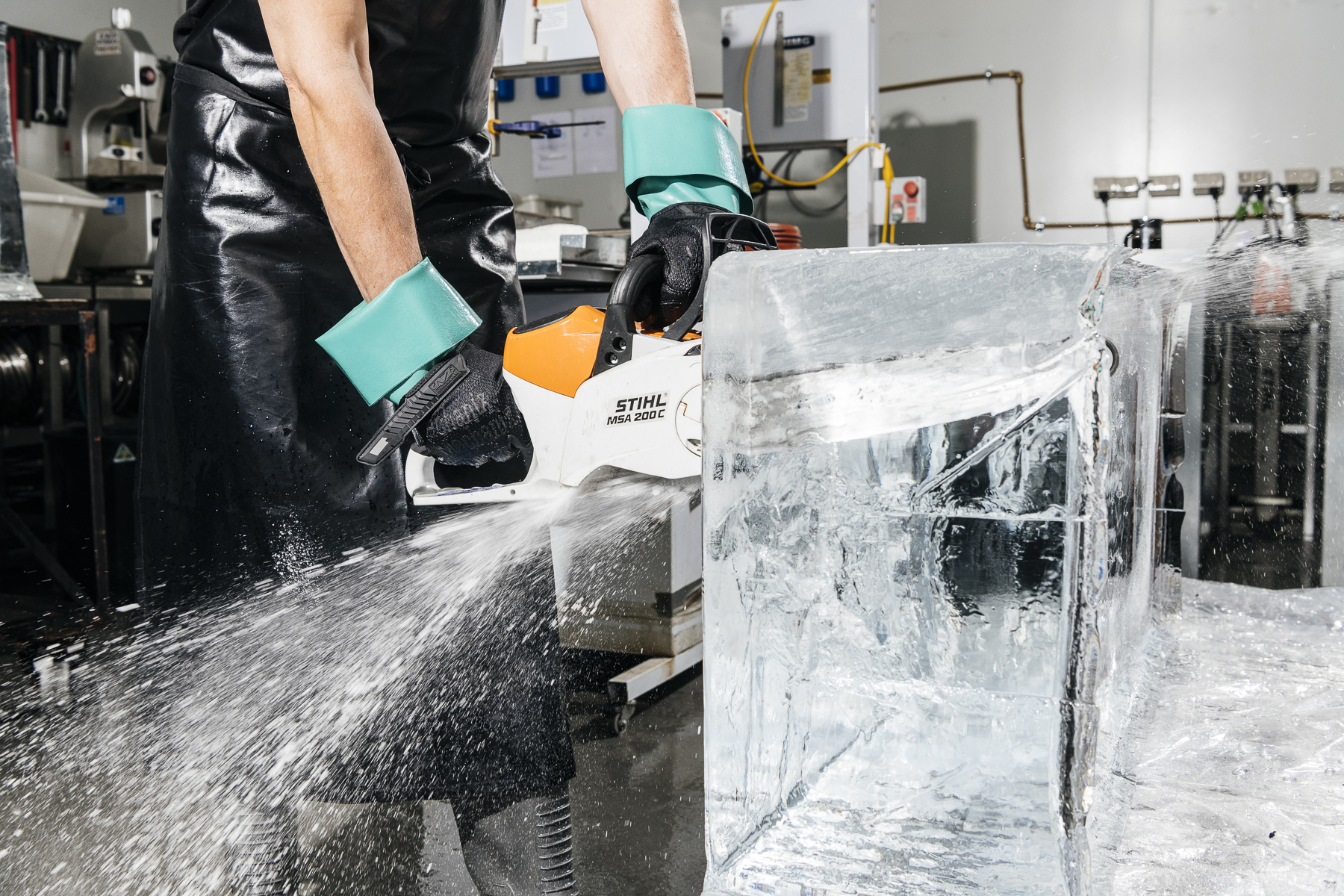
“If you want to make the best possible drink you have to consider all the ingredients,” Michael told us in 2015, when Navy Strength launched. “The only way to make the best possible drink is to make the best possible ice. It’s the final step.”
Another Made in the Shade business, Everleigh Bottling Co, launched the same year and applies this exactitude to bottled cocktails. Every week a four-strong team uses 150 litres of spirits to bottle up to 2500 Martinis, Negronis, Manhattans and Old Fashioneds at ultra-precise ratios. Everything is done by hand: filling, capping labelling, adding the heat-shrunk plastic seal. A few of these stocky little bottles stashed in the fridge are a real ace in the sleeve at dinner parties or when you have an unexpected guest. They allow anybody to make a perfect cocktail, almost instantly, albeit for $17. The company has done something no bar ever could: brought professional-quality drinks into hundreds of homes.
Home is only one good place to drink EBC’s cocktails, though. They’re a revelation somewhere like Heartbreaker, where time spent waiting for a drink is time missed dancing, or more likely, yelling profound-seeming rubbish in your mate’s ear. All the bartender needs to do is drop in the ice, slice a garnish – a twist of orange peel, say – and upend the bottle. All up, it takes less than 30 seconds. This is priceless in a world where a single drink can take five minutes or more to prepare. And the resulting cocktails are more precisely diluted (i.e. better) than anything even an experienced bartender can make from scratch.
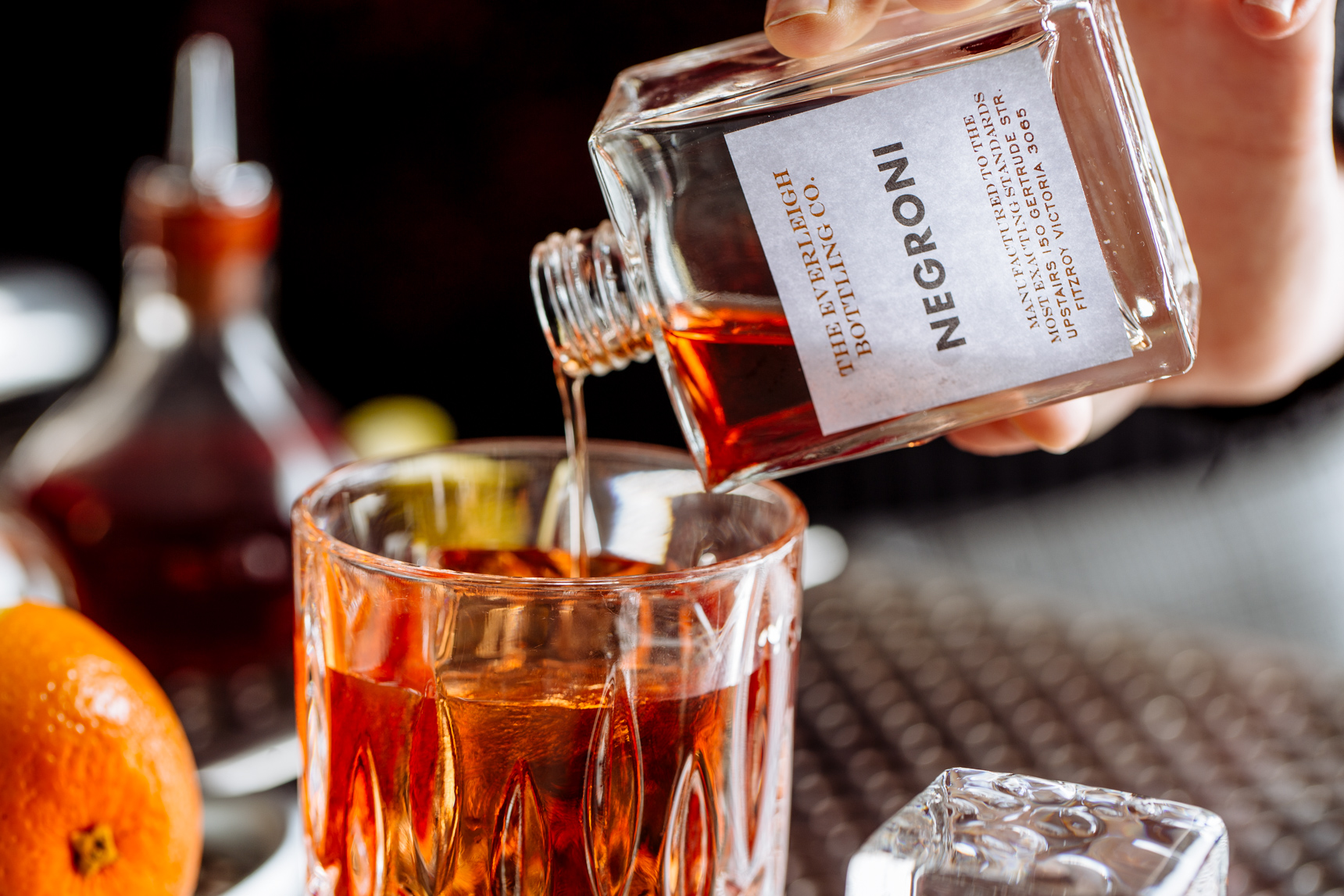
At one point we take a break to collect our thoughts. When I get back to the booth, Zara has her laptop out and Michael is answering emails on his phone. They laugh apologetically and ask if we can’t speed things along – they have a 3.30 with another journalist. Margaux’s not even finished and Zara is already revving her formidable PR engine.
And this isn’t even the only thing she has on, either. Somehow, among everything else, the duo has found time to squeeze out Spritz by EBC, a new range of sparkling cocktails available from September. Michael has been in the lab, working with flavour chemists to incorporate real lemon juice into pre-mixed drinks without reducing their shelf life. For the first time the duo is looking beyond independent bottle shops and other small retailers, to national chains. Like the original EBC line, the spritzes will bring bar-quality drinks into people’s homes – albeit on a much larger scale.
“Spritz by EBC is for a much broader audience,” Michael says. “It’s a lower price point, being a lower ABV drink. It’s something smashable, something you’re taking to the park in four-packs. Something that you dig into an esky for. It’s so much more approachable and friendly.”
The initial spritz range includes Americano (Campari, Aperol, vermouth); Fruit Cup (gin, vermouth, curacao); French 75 (gin, sparkling wine, lemon); and Have It All, a house special from the Everleigh that includes Aperol, Cocchi Americano, Cocchi Rosa and sparkling. The duo has handed production over to Brink, a professional bottling company near Ballarat. With any luck, automation will make the spritzes more affordable than their hand-bottled-cocktail cousins.
By the time we’ve finished talking about this new project, 3.30 has come and gone. We start the walk back, enjoying the weak afternoon sun filtering between the skyscrapers. At Margaux we descend the nondescript steps, back into the clamorous sounds and smells – a rude shock after the dim comfort of Heartbreaker.
Michael looks around the space with dismay. “We’re absolutely nowhere near ready for Tuesday night,” he says, referring to the first family and friends party. “We could not be further off.” I’ve learnt he can be dramatic in these situations, but I have to agree. The place looks a long way from finished.
We’re both wrong.
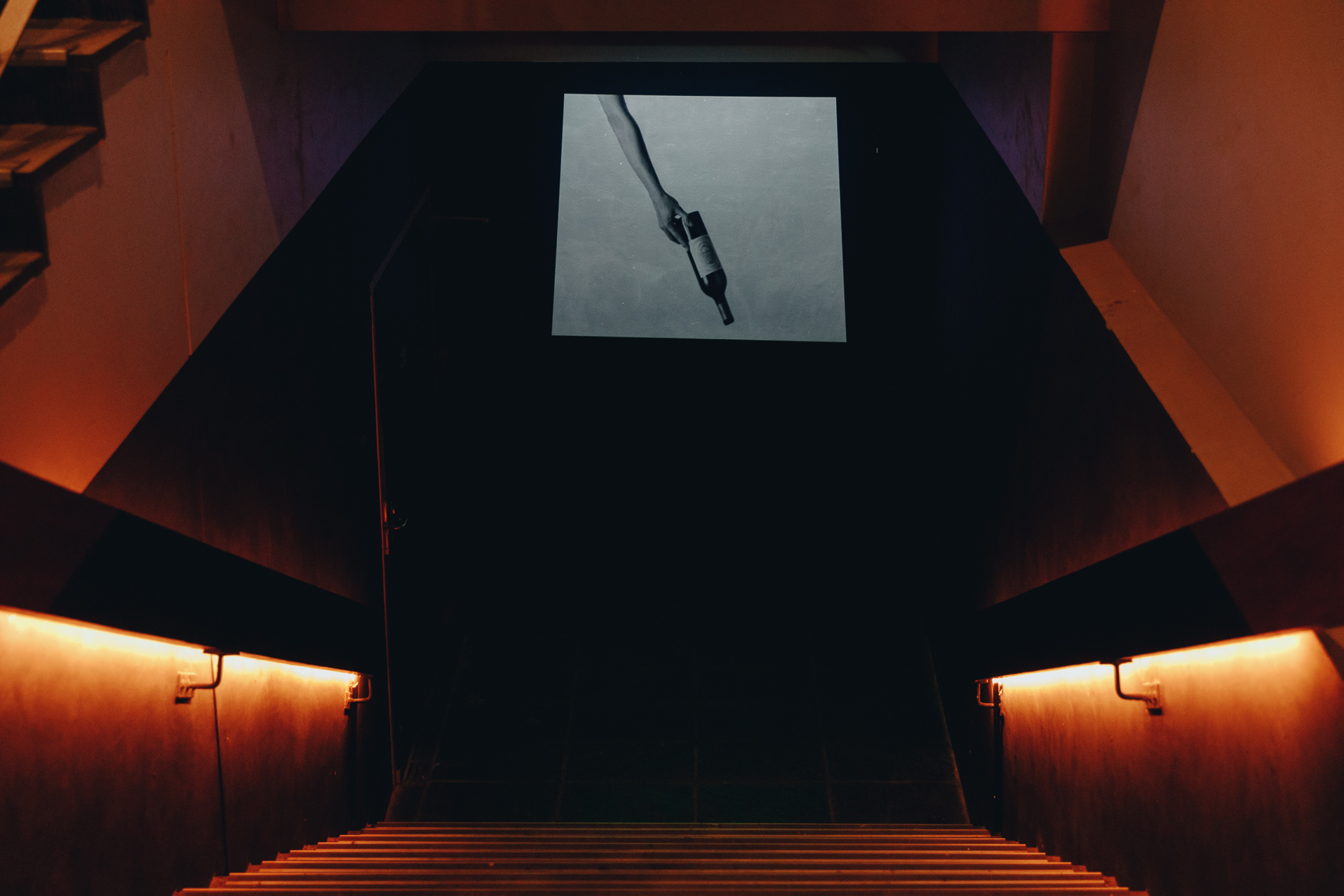
I’m back the next week, on a frigid Wednesday evening. This is the second preview the couple has organised for family, friends and media, who have the horrible task of testing the swanky basement – gratis – before it opens to the public. The long, low-ceilinged room is dim and comfortably full, but its good looks are plain to see. Burgundy upholstery. White subway tiles. Lights that glow a deep, buttery yellow. They’ve pulled it off, of course.
Already, I can sense that time moves more slowly here – that nights will stretch on forever, if you want them to. Like the Everleigh and Heartbreaker, Margaux offers an escapism more profound than just decor or location can achieve. It’s a windowless, hedonistic sort of place, where not only are lobster croque monsieurs and $50 glasses of Krug available at 4am – they seem like the greatest idea ever.
As is their habit, the Madrusans have pushed chef Daniel Southern to elevate the food through details. A decadent double-patty burger – already a classic, just a few weeks after opening – comes on 50/50 milk-brioche bun that finds the balance between sweetness and softness. Escargot shines in an aniseed-y, Pernod-spiked butter.
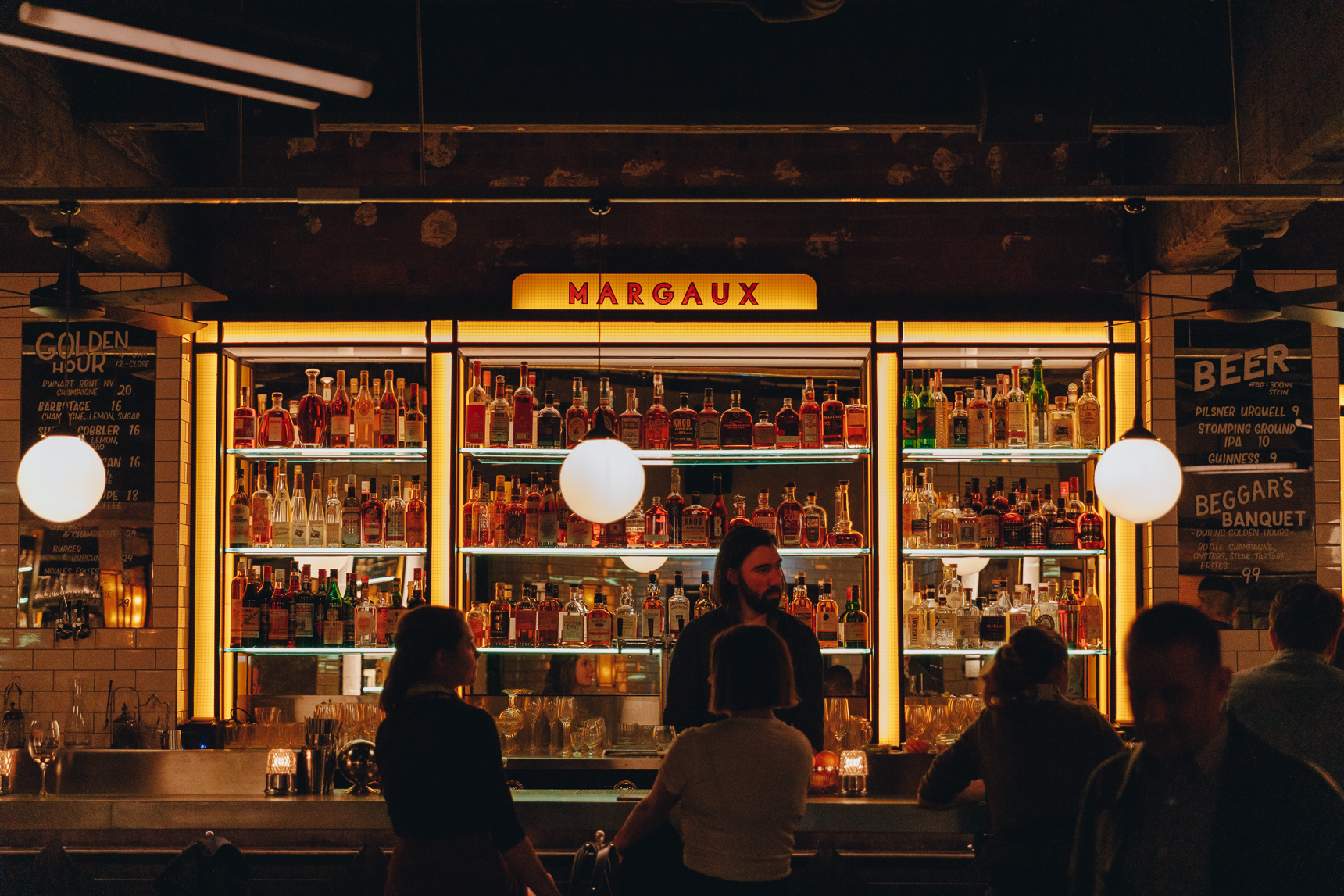
Tonight’s guests are young, smartly dressed and exuberant in the particular way you expect from people drinking for free at the city’s hottest new bar. Zara is wearing a shimmering cocktail dress and can’t stop smiling. A few steps away, Michael is talking shop with the sound guy, looking equally chipper and dapper. Waiters circulate with trays of mussels and foie gras. Others zip across the chequered floor carrying rounds of cocktails in champagne glasses. The music is loud. Handshakes, backslaps and kisses are being exchanged at a furious rate.
Before I can even make it to the thronging bar, a waiter swoops in to take my order. He hands me a lager, unbidden, while I wait for a Black Velvet, a questionable mix of Guinness and champagne Michael likes and has everyone drinking tonight. The team has clearly been told to bring the party. It’s working.
This story originally appeared in print Issue 27.
